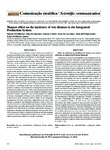Please use this identifier to cite or link to this item:
http://www.alice.cnptia.embrapa.br/alice/handle/doc/1067479| Title: | Manure effect on the incidence of rose diseases in the Integrated Production System. |
| Authors: | RIBEIRO, M. N. O.  ALMEIDA, E. F. A.   REIS, S. N.   CARVALHO, L. M.   FIGUEIREDO, J. R. M.   RIBEIRO JUNIOR, P. M.   |
| Affiliation: | MÁRCIA N. O. RIBEIRO, HOSTOS COMMUNITY COLLEGE ELKA F. A. ALMEIDA, UNIVERSIDADE FEDERAL DE MINAS GERAIS SIMONE N. REIS, EMPRESA DE PESQUISA AGROPECUÁRIA DE MINAS GERAIS LIVIA M. CARVALHO, EMPRESA DE PESQUISA AGROPECUÁRIA DE MINAS GERAIS JÚNIA R. M. FIGUEIREDO, UNIVERSIDADE FEDERAL DE LAVRAS PEDRO MARTINS RIBEIRO JUNIOR, CPATSA. |
| Date Issued: | 2016 |
| Citation: | Horticultura Brasileira, v. 34, n. 3, p. 412-415, jul./set. 2016. |
| Description: | Deficiency, excess or imbalance in the combinations of nutritional elements can influence the response of plants to pathogen infection by either increasing the level of defense or favoring the occurrence of diseases. The rose is susceptible to several pathogens and the consumer market requires flower stalks with no level of damage. Therefore, in the production of roses the application of pesticides is performed in a preventive and intensive way, which causes environmental contamination. This study evaluated the effects of chemical fertilization management and intercropping with green manure on the incidence and severity of downy mildew and powdery mildew in rosebushes grown in an Integrated Production System. The experiment was conducted in a greenhouse with ?Carolla? rosebushes. The experimental design was a randomized block with split plot in space, with eight treatments and four replications. The treatments consisted of four percentages of chemical fertilizer (25%, 50%, 75% and 100%), based on fertilization recommended for culture of rosebushes in the state of Minas Gerais, versus the presence or absence of green manure (Calopogonium mucunoides). Treatments that did not receive 100% of the chemical fertilizer had been incremented with two types of bio-fertilizers applied monthly, Bokashi (16 g/plant, applied to soil) and Supermagro (5% applied to leaves). Assessments of disease were carried out weekly on the central leaves of the productive flower stalks. In the integrated management of disease, preventive applications were made with alternative products and biological pesticides, such as neem oil (Azadirachta indica), sodium bicarbonate, bordeaux mixture, infusion of Equisetum sp., raw milk, silicon and bio-fertilizers. The alternative pesticides were efficient; however, despite reducing the frequency of application, spraying with chemical pesticides was necessary. None of the treatments related to chemical fertilization and intercropping with green manure influenced the incidence and severity of downy mildew and powdery mildew in ?Carolla? rosebushes. |
| Thesagro: | Rosa Doença Adubação Míldio |
| NAL Thesaurus: | Certification Downy mildew Powdery mildew |
| Keywords: | Sustentabilidade Certificação Sistema de Produção Integrado Rosa sp Sustainability |
| DOI: | 10.1590/S0102-05362016003017 |
| Type of Material: | Artigo de periódico |
| Access: | openAccess |
| Appears in Collections: | Artigo em periódico indexado (CPATSA)  |
Files in This Item:
| File | Description | Size | Format | |
|---|---|---|---|---|
| Pedro2016.pdf | 332.96 kB | Adobe PDF |  View/Open |









